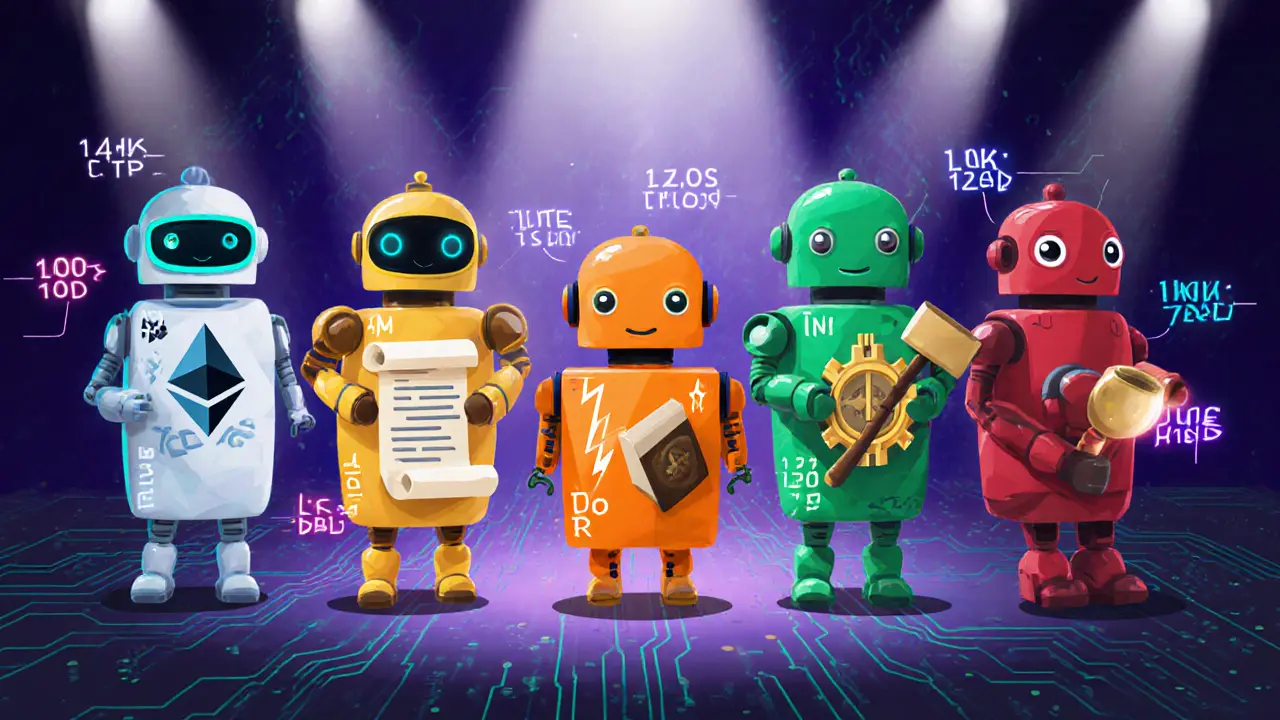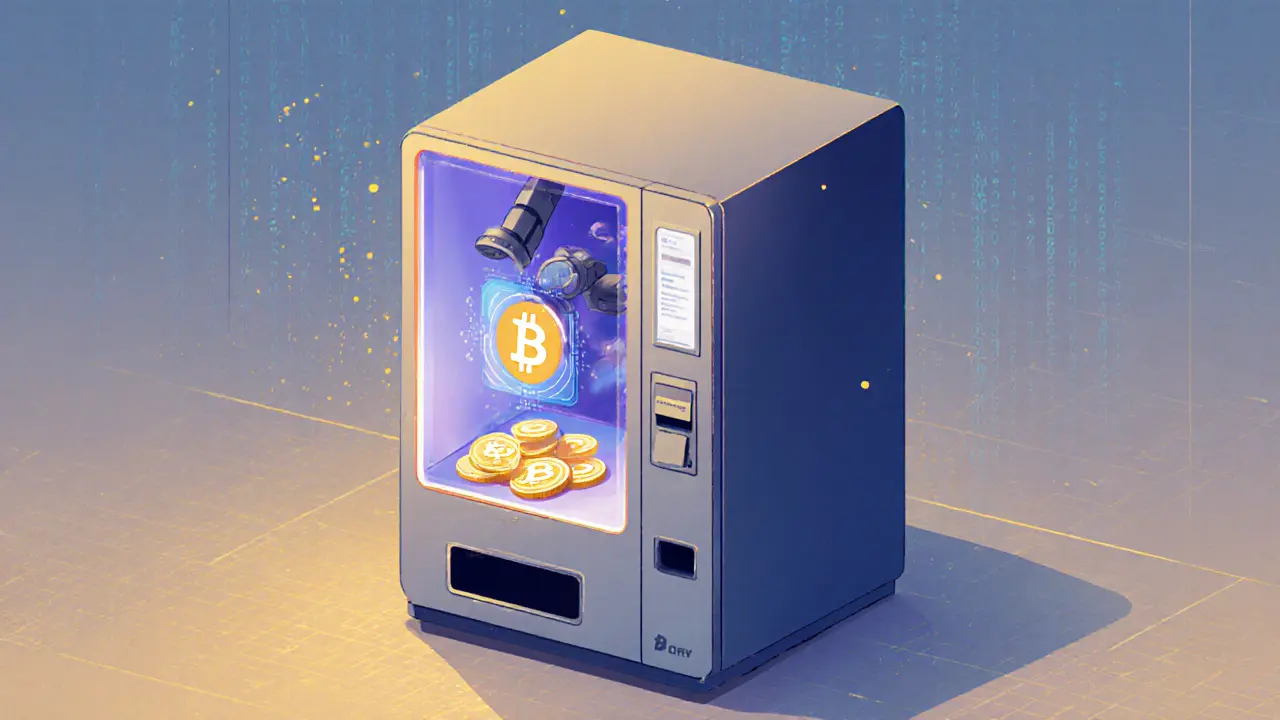Smart Contract Platform Comparison Tool
Select a blockchain platform to compare its features and capabilities for smart contract development.
Ethereum
30 TPSSolidity programming language
Popular for DeFi, NFTs, DApps
Solana
65,000 TPSRust / Anchor programming language
High-frequency trading, gaming
Cardano
250 TPSPlutus functional language
Identity, supply-chain
Tezos
1,000 TPSMichelson stack-based language
Art marketplaces, governance
Polkadot
1,000 TPSInk! (Rust-based) language
Cross-chain finance
Smart Contract Features Comparison
| Feature | Ethereum | Solana | Cardano | Tezos | Polkadot |
|---|---|---|---|---|---|
| Native Language | Solidity | Rust / Anchor | Plutus | Michelson | Ink! |
| Typical TPS | ≈30 | ≈65,000 | ≈250 | ≈1,000 | ≈1,000 |
| Primary Use Case | DeFi, NFTs, DApps | High-frequency trading, gaming | Identity, supply-chain | Art marketplaces, governance | Cross-chain finance |
| Immutability | Yes | Yes | Yes | Yes | Yes |
| Upgrade Mechanism | Proxy Pattern | Programmable Upgrade | On-chain Governance | On-chain Governance | Parachain Upgrades |
Key Insights
Smart contracts are self-executing programs stored on a blockchain that automatically enforce predetermined conditions. Ethereum remains the dominant platform for smart contracts, but newer chains like Solana offer higher throughput for specialized applications.
Each platform has its own programming language and performance characteristics. Choose based on your needs for speed, scalability, and ecosystem maturity.
When people talk about smart contracts are self‑executing code stored on a blockchain that automatically enforces agreed terms when predefined conditions are met, they’re describing a digital version of a vending machine that hands out goods as soon as you drop the right coin.
Quick Overview
- Smart contracts are code‑based agreements that run on blockchains without intermediaries.
- They rely on an "if/when…then…" logic that triggers actions automatically.
- Ethereum dominates the ecosystem, but platforms like Solana and Cardano also support contracts.
- Common use cases include DeFi, supply‑chain tracking, insurance payouts, and real‑estate settlements.
- Security hinges on flawless code - a single bug can freeze millions of dollars.
What Exactly Is a Smart Contract?
At its core, a smart contract is a program that lives on a blockchain a decentralized ledger where each block records a batch of transactions that cannot be altered once confirmed. The code is immutable after deployment, meaning no one can edit it later. When the contract’s conditions are satisfied-say a payment arrives or a certain date passes-every node on the network verifies the trigger and executes the pre‑written actions.
This architecture eliminates the need for trusted middlemen. Instead of a lawyer, a bank, or a notary, the network itself becomes the enforcer, providing transparency (everyone can see the code) and finality (once executed, it can’t be rolled back).
How Do Smart Contracts Work?
Think of a contract as a set of "if/when…then…" statements. A simple example on a cryptocurrency network might look like:
- If Account A sends 10 ETH to the contract, then release a digital token to Account B.
- If the current block timestamp reaches July12026, then transfer ownership of a real‑estate token to Account C.
When the first condition becomes true, every node runs the same code, reaches the same outcome, and writes the result as a new block. The process is fast, cheap (relative to traditional clearing), and tamper‑proof.
Key Platforms for Deploying Contracts
While the concept originated on the Bitcoin network, modern developers gravitate toward platforms that offer richer programming capabilities. Below is a snapshot of the most popular ecosystems.
| Platform | Native Language | Typical TPS | Primary Use Cases |
|---|---|---|---|
| Ethereum | Solidity | ≈30 (Layer‑2 can reach >2,000) | DeFi, NFTs, DApps |
| Solana | Rust / Anchor | ≈65,000 | High‑frequency trading, gaming |
| Cardano | Plutus | ≈250 | Identity, supply‑chain |
| Tezos | Michelson | ≈1,000 | Art marketplaces, governance |
| Polkadot | Ink! (Rust‑based) | ≈1,000 (per parachain) | Cross‑chain finance |
Programming Languages You’ll Encounter
The most widely taught language is Solidity a JavaScript‑like language designed for writing contracts on Ethereum and compatible EVM chains. It offers high‑level constructs for handling tokens, time locks, and access control.
Other ecosystems have their own dialects: Plutus a functional language based on Haskell used by Cardano, Michelson a stack‑based language powering Tezos smart contracts, and Ink! a Rust framework for Substrate‑based chains like Polkadot. Each language inherits the immutable, deterministic execution model of its host blockchain.

Real‑World Applications
Decentralized Finance (DeFi) is the poster child for contracts. Lending protocols automatically match borrowers and lenders, calculate interest, and liquidate under‑collateralized positions without a bank.
In supply‑chain the network of producers, transporters, and retailers that move goods from raw material to end consumer, contracts can verify provenance: a sensor logs a temperature reading, the contract checks compliance, then releases payment to the carrier.
Insurance companies use contracts to streamline claims: if a flight is delayed beyond a threshold, the contract releases compensation instantly, cutting out paperwork.
For real‑estate property transactions involving land or buildings, tokenized titles can be transferred automatically when escrow conditions are satisfied, reducing closing times from weeks to minutes.
Emerging IoT a network of physical devices that collect and exchange data ecosystems plan to embed contracts directly into devices-think a smart fridge that orders groceries and pays the supplier once inventory hits a low point.
Benefits You Can’t Ignore
- Trustless execution: No need to trust a third party; the code does the work.
- Transparency: Anyone can inspect the contract source before interacting.
- Speed: Transactions settle in seconds to minutes, not days.
- Cost efficiency: Eliminates fees paid to lawyers, notaries, and custodians.
- Global reach: Anyone with an internet connection can participate.
Risks and Common Pitfalls
Smart contracts are only as good as the code they contain. A single logic error can lock up funds forever-a famous example is the 2016 DAO hack that led to a $60million split and a hard fork of Ethereum.
Key vulnerabilities include:
- Re‑entrancy: Contracts calling external code that loops back and drains assets.
- Integer overflow/underflow: Miscalculations due to limited data types.
- Unchecked external calls: Trusting unverified contracts can open attack vectors.
Best practice is rigorous testing-unit tests, integration tests, and formal verification-followed by a public audit from a reputable security firm before any main‑net launch.
Step‑by‑Step: Deploying a Simple Ethereum Contract
- Install
Node.jsandnpmon your workstation. - Run
npm install -g hardhatto get the development framework. - Create a new project:
hardhat init. - Write a Solidity file
SimpleStorage.solwith a singleuint256 valueand a setter/getter function. - Compile with
npx hardhat compile. - Configure a test network (e.g., Sepolia) and fund the deployer address.
- Deploy using a script that calls
ethers.getContractFactoryanddeploy(). - Verify deployment on a block explorer, then interact via a web UI or command line.
Because the contract is immutable, any bug discovered after step8 would require deploying a brand‑new version and migrating state-a costly process.
Future Trends to Watch
Scalability solutions like rollups and sidechains are already boosting throughput, making contracts viable for high‑volume applications such as gaming and micro‑payments.
Cross‑chain contracts are emerging, letting a single piece of code trigger actions on multiple blockchains-a boon for DeFi aggregators that need to fetch price data from disparate sources.
Regulators are drafting frameworks that may require contracts to include off‑chain dispute resolution clauses, blending legal enforceability with code automation.
Finally, the integration of AI‑assisted code generation promises to lower the barrier for non‑developers, potentially expanding the smart‑contract ecosystem into everyday business processes.
Frequently Asked Questions
Do smart contracts have legal standing?
In most jurisdictions they are considered code, not a traditional legal document. However, parties can embed contracts within legally binding agreements, and courts are beginning to recognize on‑chain execution as evidence of performance.
Can I modify a smart contract after it’s deployed?
No. Immutability is a core security feature. To upgrade, developers use proxy patterns that forward calls to a newer logic contract while keeping the same address.
What’s the difference between a smart contract and a DApp?
A smart contract is the backend code that runs on chain. A DApp (decentralized application) combines that contract with a user‑interface-often a web or mobile app-that lets people interact with it.
Which platform should I choose for my first contract?
Ethereum offers the richest tooling, tutorials, and community support, making it ideal for beginners. If you need ultra‑high throughput, consider Solana, but be prepared for a steeper learning curve.
How much does it cost to run a smart contract?
Costs are measured in gas (Ethereum) or compute units (other chains). Simple contracts can run for a few cents; complex DeFi protocols may cost several dollars per transaction, especially during network congestion.


Mangal Chauhan
Welcome everyone! 😊 Let’s break down the basics so newcomers can feel confident diving into smart contracts. First, understand that a contract is just code that lives on a blockchain, immutable once deployed. It executes “if‑then” logic automatically, eliminating the need for a middle‑man. When you write Solidity, you’re essentially defining a set of rules that every node will enforce. Think of it as a digital vending machine: you insert the right token and the machine delivers the product without human oversight. The biggest advantage is transparency-anyone can audit the source before interacting. However, remember that bugs are permanent unless you build upgradeable patterns like proxies. Finally, always test thoroughly on a testnet before moving to mainnet to avoid costly mistakes. Happy coding! 🙌